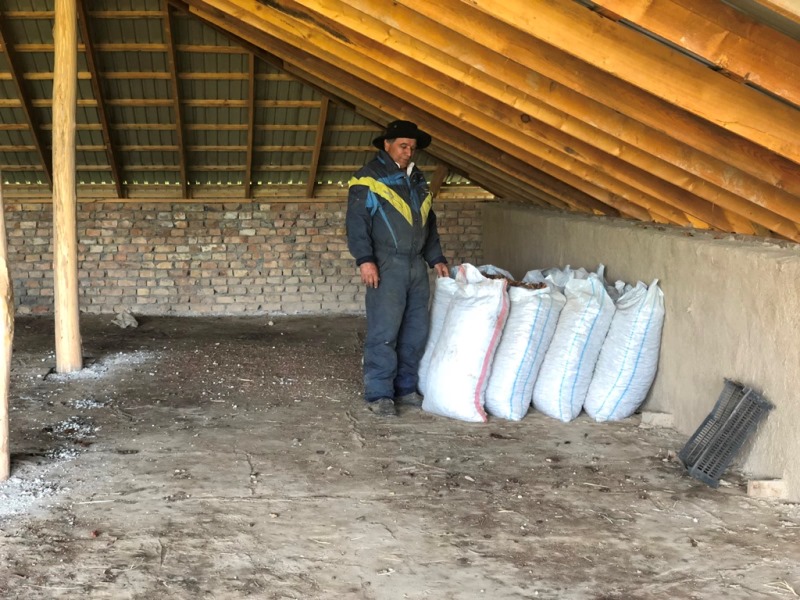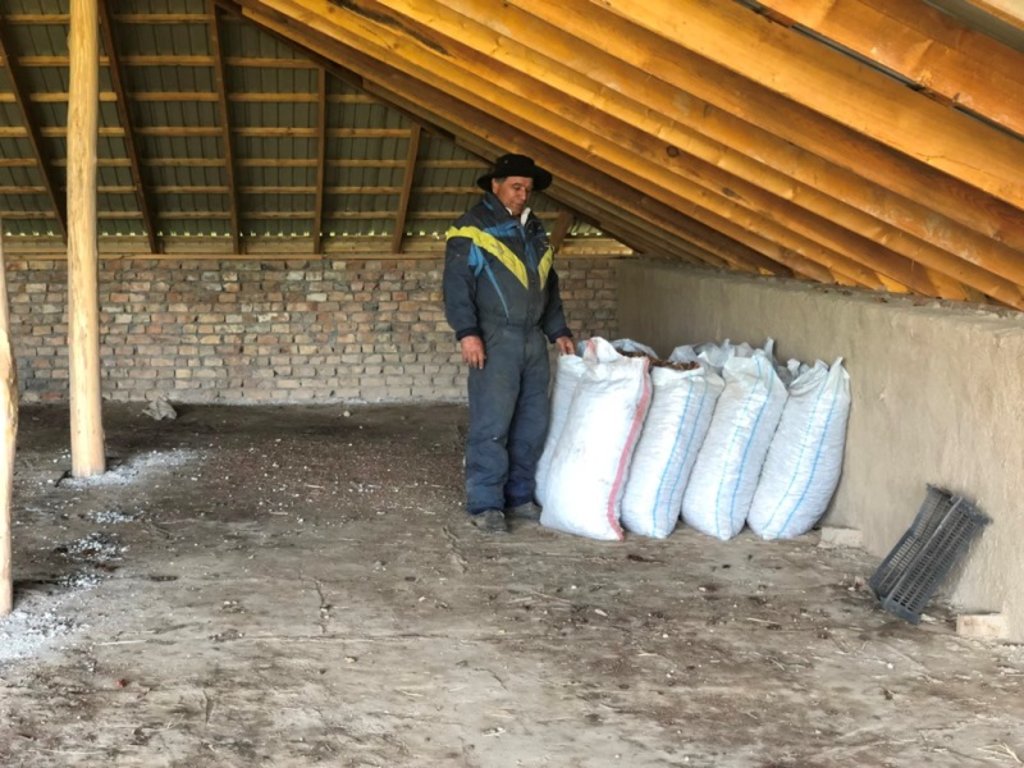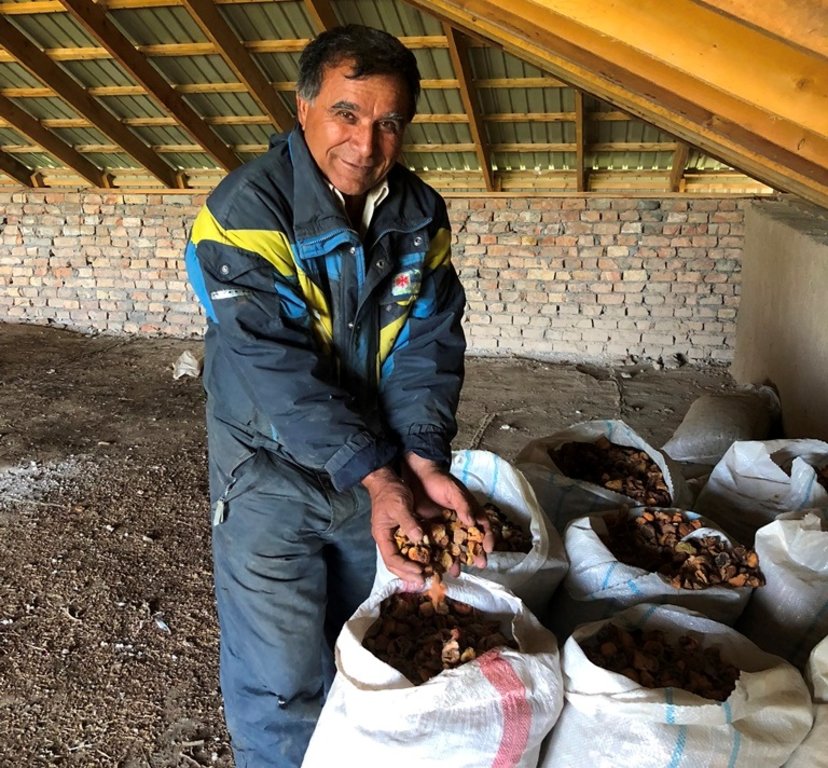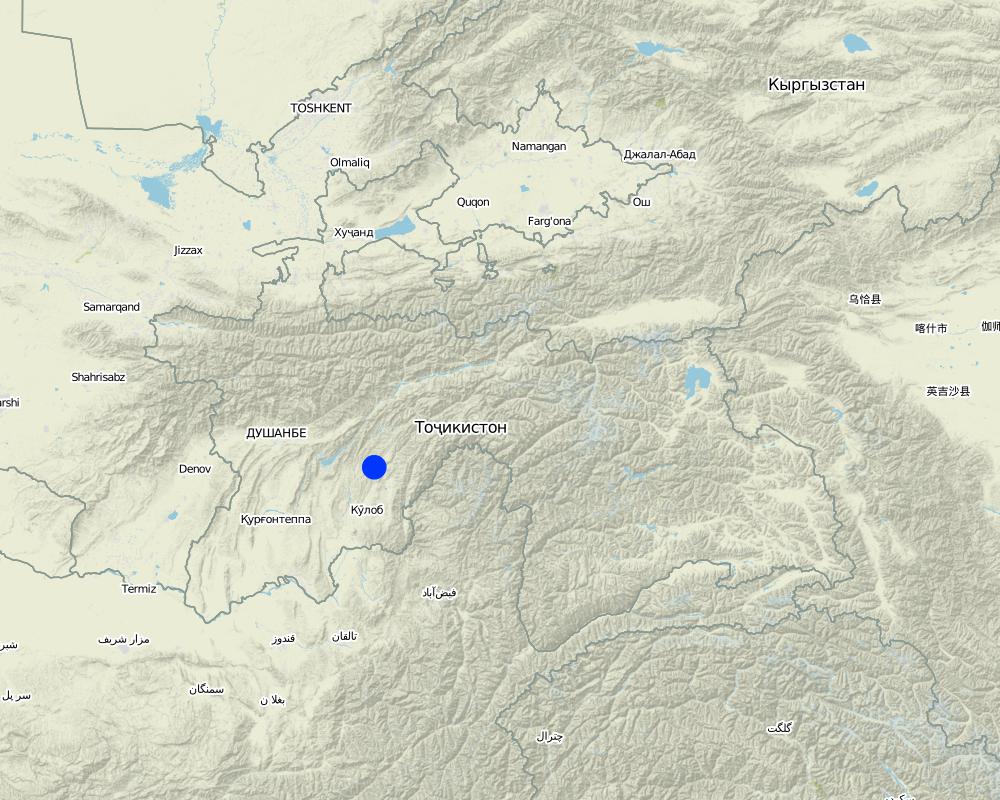Saving harvest of the orchards through drying [ຕາຈິກິສະຕານ]
- ການສ້າງ:
- ປັບປູງ:
- ຜູ້ສັງລວມຂໍ້ມູນ: Kamolidin Abdulloev
- ບັນນາທິການ: –
- ຜູ້ທົບທວນຄືນ: Farrukh Nazarmavloev
Пешгирии талафоти мева таввасути қоқкунӣ
approaches_3902 - ຕາຈິກິສະຕານ
ເບິ່ງພາກສ່ວນ
ຂະຫຍາຍທັງໝົດ ຍຸບທັງໝົດ1. ຂໍ້ມູນທົ່ວໄປ
1.2 ລາຍລະອຽດ ການຕິດຕໍ່ ຂອງບຸກຄົນທີ່ຊັບພະຍາກອນ ແລະ ສະຖາບັນ ການມີສ່ວນຮ່ວມ ໃນການປະເມີນຜົນ ແລະ ເອກະສານ ຂອງວິທີທາງ
ຊື່ຂອງໂຄງການ ທີ່ອໍານວຍຄວາມສະດວກ ໃນການສ້າງເອກກະສານ ຫຼື ປະເມີນດ້ານແນວທາງ (ຖ້າກ່ຽວຂ້ອງ)
Environmental Land Management and Rural Livelihoods (ELMAR)ຊື່ຂອງ ສະຖາບັນການຈັດຕັ້ງ ທີ່ອໍານວຍຄວາມສະດວກ ໃນການສ້າງເອກກະສານ ຫຼື ປະເມີນແນວທາງ (ຖ້າກ່ຽວຂ້ອງ)
Committee for Environment Protection of Tajikistan (Committee for Environment Protection of Tajikistan) - ຕາຈິກິສະຕານ1.3 ເງື່ອນໄຂ ຂອງການນໍາໃຊ້ເອກກະສານຂໍ້ມູນ ຂອງ WOCAT
ເມື່ອໃດທີ່ໄດ້ສັງລວມຂໍ້ມູນ (ຢູ່ພາກສະໜາມ)?
02/06/2018
ຜູ້ສັງລວມ ແລະ ບັນດາຜູ້ຕອບແບບສອບຖາມ ຍອມຮັບໃນເງື່ອນໄຂ ການນໍາໃຊ້ຂໍ້ມູນເອກະສານ ທີ່ສ້າງຂື້ນ ໂດຍຜ່ານ ອົງການ WOCAT:
ແມ່ນ
2. ພັນລະນາ ແນວທາງການຄຸ້ມຄອງນໍາໃຊ້ດິນແບບຍືນຍົງ
2.1 ການອະທິບາຍ ໂດຍຫຍໍ້ ຂອງວິທີທາງ
Gardeners in different ways store apples, pears, pomegranates, grapes and nuts for winter, but the main part of the harvest used for the animals. Proposed approach help land users to save all the harvest using drying methods.
2.2 ການອະທິບາຍ ລາຍລະອຽດ ຂອງວິທີທາງ
ການອະທິບາຍ ລາຍລະອຽດ ຂອງວິທີທາງ:
People usually used fresh fruits and store it in a different way for the winter. Therefore, to preserve freshness and juiciness, apples and granates reserved them in jars.There are many opportunities for drying fruits in Safedshahrak village of Lohuti jamoat. The village has more than 10 hectares of orchards. The village is located far from the district center at a distance of 18 km, in the north-east part of the district and at an altitude of 1300 m. The climate is humid and with abundant rainfall. Local people are mainly engaged in growing potatoes, gardening and livestock breeding. Industrial enterprises do not function in the district. A small number of women study at Medical College and a vocational technical school or attend a special high and secondary schools in Dushanbe to get any skills. However, working places are only available in the central district hospital and general education schools for 5-6% of the total number of qualified women.
The project provides small-scale grants at the village level for groups of households to implement rural production and land management investments, as well as related small-scale infrastructure investments.Villages will prioritize investments based on a fixed budget for each type of rural investment, determined by the number of households
The CIG established in Safedshahrak village, which consisted of 25 members, and they recognize their work on drying fruits as an advantage in the first place. With the support of the project, the CIG was purchased and installed tools and equipment for drying fruit, and put production into operation.
Abdukodir Gozaev, a head of CIG, made all preparations for the construction of a warehouse for drying fruits, organized work on harvesting and drying fruit according to the plan. As a result, the rural people collected 60 tons of fresh fruit, which were dried. There are 3.5 tons of dried apples, 3.5 tons of cherries, 1 ton of rose hips and 0.5 tons of plums in the group's warehouse. Collected products were sold, and the sale profit was TJS 21950 (2,488$). The CIG head paid to the population from the funds received after the sale. In the future, he intends to prepare special boxes and sell them with packed dried fruit. This type of activity will give the opportunity to adapt their products to market requirements
2.3 ຮູບພາບຂອງແນວທາງ
2.5 ປະເທດ / ເຂດ / ສະຖານທີ່ບ່ອນທີ່ແນວທາງໄດ້ຖືກນໍາໃຊ້
ປະເທດ:
ຕາຈິກິສະຕານ
ພາກພື້ນ / ລັດ / ແຂວງ:
Kulob Region, Khovaling District
ຂໍ້ມູນເພີ່ມເຕີມຂອງສະຖານທີ່:
Jamoat Lohuti, Safedshahrak village
ຄວາມຄິດເຫັນ:
An approach was implemented in the Khovaling district, Lohuti jamoat, Safedshahrak village
Map
×2.6 ວັນທີເລີ່ມຕົ້ນ ແລະ ສິ້ນສຸດ ການຈັດຕັ້ງປະຕີບັດ ວິທີທາງ
ສະແດງປີຂອງການເລີ່ມຕົ້ນ:
2016
ປີທີ່ສີ້ນສູດ (ຖ້າຢຸດບໍ່ໄດ້ນໍາໃຊ້ ວິທີທາງ):
2017
ຄວາມຄິດເຫັນ:
An approach technical part done during the 2 month and after project monitored it, presently CIG is managing and maintaining
2.7 ປະເພດຂອງແນວທາງ
- ພາຍໃຕ້ໂຄງການ / ແຜນງານ
2.8 ເປົ້າໝາຍ / ຈຸດປະສົງຫຼັກ ຂອງການຈັດຕັ້ງປະຕິບັດ ວິທີທາງ
Supporting gardeners to improve the management of the orchards and to save their harvest using drying fruit approach, by this way to raise the household income
2.9 ເງື່ອນໄຂອໍານວຍ ຫຼື ຂັດຂວາງການປະຕິບັດຂອງເຕັກໂນໂລຢີ / ເຕັກໂນໂລຢີການນໍາໃຊ້ຕາມແນວທາງ
ສັງຄົມ / ວັດທະນະທໍາ / ມາດຕະຖານ ແລະ ຄຸນຄ່າທາງສາສະໜາ
- ອໍານວຍ
People usually used fresh fruits or stored apples, pears, grapes and nuts for winter only as the juice and did not drying them. Duirng the season gardenners lost thousands tons of the fruits that were the main part of their harvest
As the result of the project there were appeared an opportunity to save all the harvest from their orchards and additionaly have income from that
ມີຄວາມສາມາດ / ເຂັ້າເຖິງຊັບພະຍາກອນດ້ານການເງິນ ແລະ ການບໍລິການ
- ອໍານວຍ
Gardeners used only fresh fruits and did not use the main part of their harvest as a result, the rural people collected 60 tons of fresh fruit, which were dried. There are 3.5 tons of dried apples, 3.5 tons of cherries, 1 ton of rose hips and 0.5 tons of plums in the group's warehouse. Collected products were sold and have a good profit. The CIG head paid to the CIG Members (local Land Users) from the funds received after the sale. In the future, he intends to prepare special boxes and sell them with packed dried fruit. This type of activity will give the opportunity to adapt their products to market requirements.
ການກໍ່ຕັ້ງສະຖາບັນ
- ອໍານວຍ
As the result of the project established the Common Interest Group that will manage and maintain the approach in future
ຄວາມຮູ້ກ່ຽວກັບການຄຸ້ມຄອງ ທີ່ດິນແບບຍືນຍົງ, ການເຂົ້າເຖິງການສະໜັບສະໜູນ ທາງດ້ານວິຊາການ
- ເຊື່ອງຊ້ອນ
Lack of knowledge on SLM approaches and technologies There was organised different type of SLM relative trainings on behalf of the project during the approach implementation
3. ການມີສ່ວນຮ່ວມ ແລະ ບົດບາດຂອງພາກສ່ວນທີ່ກ່ຽວຂ້ອງທີ່ໄດ້ມີສ່ວນຮ່ວມ
3.1 ຜູ້ມີສ່ວນຮ່ວມ ໃນວິທີທາງ ແລະ ພາລະບົດບາດ ຂອງເຂົາເຈົ້າ
- ຜູ້ນໍາໃຊ້ດິນໃນທ້ອງຖິ່ນ / ຊຸມຊົນທ້ອງຖິ່ນ
Gardeners (CIG Members)
Local land users prioritized investments based on a fixed budget for each type of rural investment determined by the number of households. Within a plan of action, participants decided on the allocation of investments to groups of households using rules that limit the funding for any one household.
- ຜູ້ຊ່ຽວຊານ ການນຄຸ້ມຄອງ ທີ່ດິນແບບຍືນຍົງ / ທີ່ປຶກສາດ້ານກະສິກໍາ
Reprezentatives from the project parners and government institutions
Reprezentaives from the facilitating organisations and professors (as TOT trainers) from the Institutions and academies involved during the trainings
- ອໍານາດ ການປົກຄອງທ້ອງຖິ່ນ
Hukumat and jamoat reprezentatives
Jamoat representatives were involved in Participatory Rural Appraisal (PRA) that was used as the main pre-assessment mechanism to analyze the socio-economic and environmental situation in the selected pilots, The RRC(Rayon Review Committee) will consider the combination of proposed sub-projects within the overall context of the rayon and project. The committee will review and accept proposals that meet project guidelines and provide clearance to the IG for the release of project funding to the accounts of relevant CIGs.
3.2 ການມີສ່ວນຮ່ວມຂອງຜູ້ນໍາໃຊ້ທີ່ດິນໃນທ້ອງຖິ່ນ / ຊຸມຊົນທ້ອງຖິ່ນໃນໄລຍະທີ່ແຕກຕ່າງກັນຂອງແນວທາງ
| ການລວບລວມ ເອົາຜູ້ນໍາໃຊ້ດິນ ໃນທ້ອງຖິ່ນ / ຊຸມຊົນທ້ອງຖິ່ນ | ໃຫ້ລະບຸ ຜູ້ໃດທີ່ມີສ່ວນຮ່ວມ ໃນແຕ່ລະກິດຈະກໍາ? | |
|---|---|---|
| ການວາງແຜນ | ການບໍ່ປະຕິບັດ | Project beneficiaries (CIG Members) interviewed and consulted during the social assessment conducted in the project design process which then influenced project approaches. |
| ການປະຕິບັດ | ການຮ່ວມມື | During the Participatory and Community Action Planning Villagers (CIG Members) made grant allocation decisions. After the supporting CIGs proposals, they had managed grant funds and purchased needed materials and products individually |
| ຕິດຕາມກວດກາ / ການປະເມີນຜົນ | ການບໍ່ປະຕິບັດ | active participation of the local land users during the monitoring process |
3.3 ແຜນວາດ (ຖ້າມີ)
3.4 ການຕັດສິນໃຈກ່ຽວກັບການຄັດເລືອກເຕັກໂນໂລຢີຂອງການຄຸ້ມຄອງທີ່ດິນແບບຍືນຍົງ / ເຕັກໂນໂລຢີ
ລະບຸ ຄົນທີ່ຕັດສິນໃຈ ກ່ຽວກັບການຄັດເລືອກຂອງ ເຕັກໂນໂລຢີ / ເຕັກໂນໂລຢີ ຈະໄດ້ຮັບການປະຕິບັດ:
- ຜູ້ນໍາໃຊ້ທີ່ດິນຫຼັກ, ການສະໜັບສະໜູນ ໂດຍຜູ້ຊ່ຽວຊານ ການນໍາໃຊ້ທີ່ດິນແບບຍືນຍົງ
ອະທິບາຍ:
Local land users prioritized investments based on a fixed budget for each type of rural investment determined by the number of households. Within a plan of action, participants decided on the allocation of investments to groups of households using rules that limit the funding for any one household.
Specify on what basis decisions were made:
- ປະເມີນເອກກະສານ ຄວາມຮູ້ກ່ຽວກັບ ການຄຸ້ມຄອງ ທີ່ດິນແບບຍືນຍົງ (ຫຼັກຖານທີ່ຊ່ວຍໃນການຕັດສິນໃຈ)
- Project initial phases
4. ການສະໜັບສະໜູນທາງດ້ານວິຊາການ, ການສ້າງຄວາມສາມາດ, ແລະ ການຈັດການຄວາມຮູ້.
4.1 ການສ້າງຄວາມສາມາດ / ການຝຶກອົບຮົມ
ຜູ້ນໍາໃຊ້ທີ່ດິນ ຫຼື ພາກສ່ວນກ່ຽວຂ້ອງອື່ນໆ ໄດ້ຮັບການຝຶກອົບຮົມບໍ່?
ແມ່ນ
ໃຫ້ລະບຸ ຜູ້ໃດທີ່ໄດ້ຮັບການຝຶກອົບຮົມ:
- ຜູ້ນໍາໃຊ້ດິນ
ຖ້າເປັນໄປໄດ້, ໃຫ້ລະບຸເພດ, ອາຍຸ, ສະຖານະພາບ, ຊົນເຜົ່າ, ແລະ ອື່ນໆ:
It was provided full participation of the male and female as it was a planned by project indicator
ຮູບແບບຂອງການຝຶກອົບຮົມ:
- ການເຮັດຕົວຈິງ
- ຕົວຕໍ່ຕົວ
- ກອງປະຊຸມ
ໃນຫົວຂໍ້:
Financial management, reporting, subproject/approach management and technical, SLM reletive trainings
ຄວາມຄິດເຫັນ:
Composting, mulching, managing salinization, intercropping on slopes, drip irrigation, low-cost watering techniques, solar greenhouses, drought-resistant crops, bee-keeping, mixed fruit orchards (planting, growing process, harvesting and marketing), local varieties nurseries, rotational grazing, Livestock breeding and maintaining, strategic watering points, use of perennial forage and marketing options (how to manage and prepare the harvest to the market) and opportunities was provided for the land user during the project implementation.
4.2 ການບໍລິການໃຫ້ຄໍາປຶກສາ
ເຮັດຜູ້ໃຊ້ທີ່ດິນມີການເຂົ້າເຖິງການບໍລິການໃຫ້ຄໍາປຶກສາ?
ແມ່ນ
ລະບຸວ່າການສະໜອງ ການບໍລິການ ໃຫ້ຄໍາປຶກສາ:
- ໃນພື້ນທີ່ຂອງຜູ້ນໍາໃຊ້ດິນ
- ສູນຄົ້ນຄວ້າ
ອະທິບາຍ / ຄວາມຄິດເຫັນ:
Jamoat (agronomist, ecologist and other specialists) advise CIG Members
4.3 ສະຖາບັນການສ້າງຄວາມເຂັ້ມແຂງ (ການພັດທະນາອົງການຈັດຕັ້ງ)
ສະຖາບັນ ໄດ້ຮັບການສ້າງຕັ້ງຂື້ນ ຫຼື ໄດ້ຮັບການສ້າງຄວາມເຂັ້ມແຂງ ໂດຍການຈັດຕັ້ງປະຕິບັດ ວິທີທາງບໍ່?
- ມີ, ໜ້ອຍໜຶ່ງ
ລະບຸ ທາງສະຖາບັນ ໄດ້ສ້າງຄວາມເຂັ້ມແຂງ ໃນລະດັບໃດ (ຫຼາຍ):
- ທ້ອງຖິ່ນ
ອະທິບາຍ ສະຖາບັນການຈັດຕັ້ງ, ພາລະບົດບາດ ແລະ ໜ້າທີ່ຮັບຜິດຊອບ, ສະມາຊິກ ແລະ ອື່ນໆ.
The Common Interest Groups formed in the villages on behalf households and enhanced their knowledge. And the project provides small-scale grants at the village level for groups of households (CIG) to implement rural production and land management investments, as well as related small-scale infrastructure investments. Villages will prioritize investments based on a fixed budget for each type of rural investment, determined by the number of households.
ລະບຸ ປະເພດ ຂອງສະໜັບສະໜູນ:
- ທາງດ້ານການເງິນ
- ການສ້າງຄວາມອາດສາມາດ / ການຝຶກອົບຮົມ
ໃຫ້ລາຍລະອຽດເພີ່ມເຕີມ:
Project-financed grants to CIGs for each investment under categories of rural production and land management investments, as well as related small-scale infrastructure investments that will not exceed US$7,000 and will require a match of 25% in beneficiary contributions which may be in cash or in-kind
4.4 ຕິດຕາມກວດກາ ແລະ ປະເມີນຜົນ
ການຈັດຕັ້ງປະຕິບັດ ວິທີທາງ ໄດ້ມີການປະເມີນຜົນ ແລະ ຕິດຕາມບໍ?
ແມ່ນ
ຄວາມຄິດເຫັນ:
environmental aspects, management of the investments, and other social and economic issues
ຖ້າແມ່ນ, ເອກກະສານສະບັບນີ້ ແມ່ນໄດ້ນໍາໃຊ້ເຂົ້າໃນການຕິດຕາມ ແລະ ປະເມີນຜົນບໍ່?
ແມ່ນ
ຄວາມຄິດເຫັນ:
FOs build CIG capacities to monitor these aspects and to adapt to changing conditions.
4.5 ການຄົ້ນຄວ້າ
ນີ້້ແມ່ນສ່ວນໜຶ່ງ ການຄົ້ນຄວ້າ ຂອງວິທີທາງບໍ່?
ບໍ່ແມ່ນ
5. ການສະໜັບສະໜູນທາງດ້ານການເງິນ ແລະ ອຸປະກອນຈາກພາຍນອກ
5.1 ງົບປະມານປະຈໍາປີ ສໍາລັບວິທີທາງ ຂອງການຄຸ້ມຄອງ ທີ່ດິນແບບຍືນຍົງ
ຖ້າຫາກບໍ່ຮູ້ຈັດງົບປະມານທີ່ແນ່ນອນ ແມ່ນໃຫ້ປະມານເອົາ:
- 2,000-10,000
ຄໍາເຫັນ (ຕົວຢ່າງ: ແຫຼ່ງຂໍ້ມູນຫຼັກ ຂອງການສະໜອງທຶນ / ຜູ້ໃຫ້ທຶນທີ່ສໍາຄັນ):
GEF/PPCR through WB
5.2 ການສະໜັບສະໜູນ ທາງດ້ານການເງິນ / ອຸປະກອນ ສະໜອງໃຫ້ແກ່ຜູ້ນໍາທີ່ດິນ
ຜູ້ນໍາໃຊ້ດິນ ໄດ້ຮັບການສະໜັບສະໜູນ ທາງດ້ານ ການເງິນ / ອຸປະກອນ ໃນການຈັດຕັ້ງປະຕິບັດ ເຕັກໂນໂລຢີບໍ?
ແມ່ນ
ຖ້າແມ່ນ, ໃຫ້ລະບຸປະເພດ (ຫຼາຍ) ຂອງການສະໜັບສະໜູນ, ເງື່ອນໄຂ ແລະ ຜູູ້ສະໜອງ (ຫຼາຍ):
The project financed investments in three categories that are expected to improve household assets and sustainable land management, and build climate resilience,
The CIGs prepared proposals for investments that included basic data on beneficiaries and funding requirements, the objectives and the issue/opportunity that is being addressed, description of the investment and activities (including a work plan and budget), summary of environmental, economic and social feasibility and sustainability measures, and a brief monitoring and evaluation plan.
Project financed grants to the CIGs that not exceed US$7,000 and will require a match of 25% in beneficiary contributions which may be in cash or in-kind. The grants disbursed in tranches directly to beneficiaries or groups to their own bank account
5.3 ເງິນສົມທົບສໍາລັບການນໍາໃຊ້ສະເພາະປັດໃຈຂາເຂົ້າໃນການຜະລີດກະສິກໍາ (ລວມທັງແຮງງານ)
- ບໍ່ມີ
ຖ້າແຮງງານ ຂອງຜູ້ນໍາໃຊ້ດິນ ໄດ້ຮັບການສະໜັບສະໜູນ ປັດໃຈຂາເຂົ້າ, ແມ່ນບໍ່:
- ການອາສາ
ຄວາມຄິດເຫັນ:
Land users contributed more then 25% for the total approach amount, and it was as an kind (local materials, labour). The CIG membes prepare building and reconstructed it for their project as it was community contribution.
5.4 ສິນເຊື່ອ
ໄດ້ປ່ອຍສິນເຊື່ອ ສະໜອງໃຫ້ພາຍໃຕ້ ວິທີການສໍາລັບກິດຈະກໍາ ການຄຸ້ມຄອງ ທີ່ດິນແບບຍືນນຍົງບໍ່?
ບໍ່ແມ່ນ
5.5 ສິ່ງຈູງໃຈ ຫຼື ເຄື່ອງມືອື່ນໆ
ການສົ່ງເສີມ ຈັດຕັ້ງປະຕິບັດ ເຕັກໂນໂລຢີ ໃນການຄຸ້ມຄອງ ດິນແບບຍືນຍົງ ໄດ້ສະໜອງສິ່ງກະຕຸກຊຸກຍູ້ບໍ່?
ແມ່ນ
ຖ້າແມ່ນ, ໃຫ້ລະບຸ:
Study tours, competition farmer to farmer
6. ວິເຄາະຜົນກະທົບ ແລະ ສັງລວມບັນຫາ
6.1 ຜົນກະທົບຂອງແນວທາງ
ວິທີທາງ ຊ່ວຍຊຸກຍູ້ ຜູ້ນຳໃຊ້ທີ່ດິນທ້ອງຖີ່ນ, ໃນການປັບປຸງ ການມີສ່ວນຮ່ວມ ຂອງຜູ້ທີ່ກ່ຽວຂ້ອງ ບໍ່?
- ບໍ່
- ມີ, ໜ້ອຍໜຶ່ງ
- ມີ, ພໍສົມຄວນ
- ມີ, ຫຼາຍ
As a result, the rural people collected 60 tons of fresh fruit, which were dried. There are 3.5 tons of dried apples, 3.5 tons of cherries, 1 ton of rose hips and 0.5 tons of plums in the group's warehouse. Collected products were sold, in the local market. Local land users paid to their members from the funds received after the sale.
ການນໍາໃຊ້ ວິທີທາງ ສາມາດປັບປຸງຄວາມຮູ້ ແລະ ຄວາມສາມາດຂອງຜູ້ນໍາໃຊ້ທີ່ດິນ ໃນການປະຕິບັດ ການຄຸ້ມຄອງ ທີ່ດິນແບບຍືດຍົງໄດ້ບໍ່?
- ບໍ່
- ມີ, ໜ້ອຍໜຶ່ງ
- ມີ, ພໍສົມຄວນ
- ມີ, ຫຼາຍ
A big bunch of the training and meetings had been organized with the CIG (local land users) that will give them an opportunity to manage and maintain on hand approach
During establishment of CIG, which consists of 25 people, members of the group, 9 of whom are married women, and they recognize their work on drying fruits as an advantage in the first place.
In the future, the local land users intends to prepare special boxes and sell them with packed dried fruit. This type of activity will give the opportunity to adapt their products to market requirements.
The project gives CIG members a ery good opportunity not only to save their harvest but have not bad income from this. I the future the CIG mambers planned to think about the marketing issues packaging dried fruits and adapt it to the market requirementsand find more profit.
6.2 ແຮງຈູງໃຈຫຼັກຂອງຜູ້ນໍາໃຊ້ທີ່ດິນໃນການປະຕິບັດການຄຸ້ມຄອງທີ່ດິນແບບຍືນຍົງ
- ການຜະລິດເພີ່ມຂຶ້ນ
As a result, the rural people collected 60 tons of fresh fruit, which were dried. There are 3.5 tons of dried apples, 3.5 tons of cherries, 1 ton of rose hips and 0.5 tons of plums in the group's warehouse.
- ການປັບປຸງ ຄວາມຮູ້ ແລະ ຄວາມສາມາດ ຂອງການຄຸ້ມຄອງ ທີ່ດິນແບບຍືນຍົງ
The local land users (CIG Members) participated in SLM training
6.3 ຄວາມຍືນຍົງຂອງກິດຈະກໍາວິທີທາງ
ຜູ້ນໍາໃຊ້ ທີ່ດິນ ສາມາດສືບຕໍ່ ການຈັດຕັ້ງປະຕິບັດ ຜ່ານວິທີທາງໄດ້ບໍ່ (ໂດຍປາດສະຈາກ ການຊ່ວຍເຫຼືອ ຈາກພາກສ່ວນພາຍນອກ)?
- ແມ່ນ
ຖ້າ ໄດ້, ອະທິບາຍເຫດຜົນ:
The local land user from the beginning did all the activities individually after the training that was provided by the project. made grant allocation decisions, also CIGs managed grant funds and bought inputs. Maintaining actions are in place
6.4 ຈຸດແຂງ / ຂໍ້ດີ ຂອງວິທີທາງ
| ຈຸດແຂງ / ຂໍ້ດີ / ໂອກາດໃນການນໍາໃຊ້ທີ່ດິນ |
|---|
| The head of CIG is the specialist and knows all the details of the activity that help them better manage and maitain an approach |
| The building and the local materials that was used during the project belonged to the CIG members and it gives them opportunity to implement such project |
| ຈຸດແຂງ / ຈຸດດີ / ໂອກາດ ຈາກທັດສະນະຂອງຜູ້ປ້ອນຂໍ້ມູນ ຫຼື ບຸກຄົນສຳຄັນ |
|---|
| Being in a group(CIG), gives opportunity to do desicions together and expanding approach in the plan |
| Capacity building events that was organised during the approach, new technologies, new knowledges and so on |
| Good cooperation with the jamoat |
6.5 ຈຸດອ່ອນ / ຂໍ້ເສຍຂອງແນວທາງ ແລະ ວິທີການແກ້ໄຂໃຫ້ເຂົາເຈົ້າ
| ຈຸດອ່ອນ ຫຼື ຂໍ້ເສຍ ຫຼື ຄວາມສ່ຽງ ໃນມຸມມອງຂອງ ຜູ້ສັງລວມຂໍ້ມູນ ຫຼື ບັນດາຜູ້ຕອບແບບສອບຖາມ | ມີວິທີການແກ້ໄຂຄືແນວໃດ? |
|---|---|
| Market, value chance, preparation of the business plans and other reletive knowledges they need | Other coming projects or local hukumat needs to support them |
7. ເອກກະສານອ້າງອີງ ແລະ ຂໍ້ມູນການເຊື່ອມໂຍງ
7.1 ວິທີການ / ແຫຼ່ງຂໍ້ມູນ
- ການສໍາພາດ ຜູ້ນໍາໃຊ້ທີ່ດິນ
Local land users (CIG Members)
- ສໍາພາດ ຊ່ຽວຊານ ການຄຸ້ມຄອງ ດິນແບບຍືນຍົງ
ELMARL Specialists
- ການລວບລວມ ບົດລາຍງານ ແລະ ເອກະສານອື່ນໆ ທີ່ມີຢູ່ແລ້ວ
Project progress reports and other documents
7.2 ເອກະສານທົ່ວໄປທີ່ສາມາດໃຊ້ໄດ້
ຫົວຂໍ້, ຜູ້ຂຽນ, ປີ, ISBN:
ELMARL Annual Report 2017
7.3 ການເຊື່ອມຕໍ່ກັບຂໍ້ມູນທີ່ກ່ຽວຂ້ອງທີ່ສາມາດໃຊ້ອອນໄລນ໌
ຫົວຂໍ້ / ພັນລະນາ:
Knowledge Management platform on SLM
URL:
https://slmtj.net
ຂໍ້ມູນການເຊື່ອມຕໍ່ ແລະ ເນື້ອໃນ
ຂະຫຍາຍທັງໝົດ ຍຸບທັງໝົດການເຊື່ອມຕໍ່
ບໍ່ມີຂໍ້ມູນການເຊື່ອມຕໍ່
ເນື້ອໃນ
ບໍ່ມີເນື້ອໃນ






